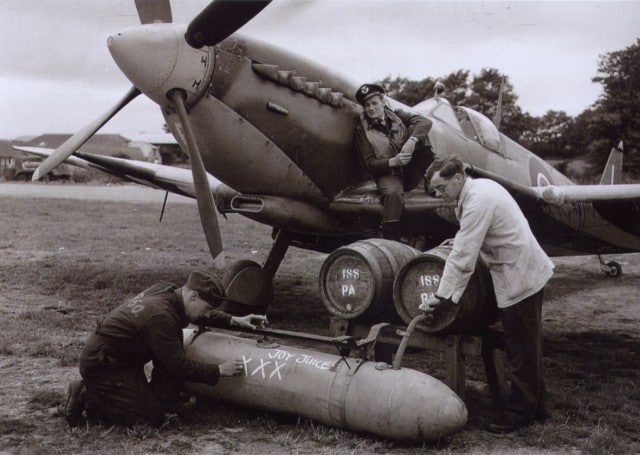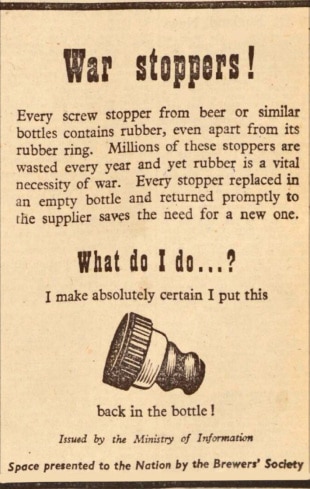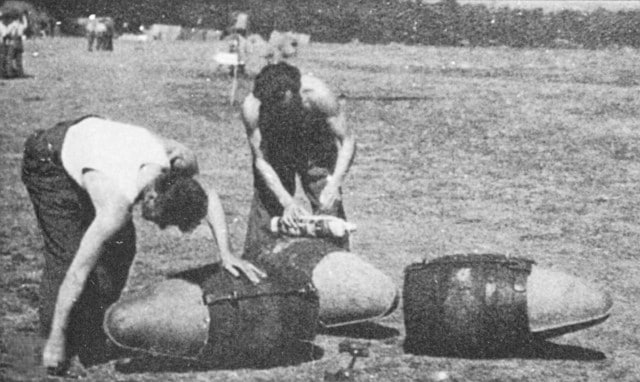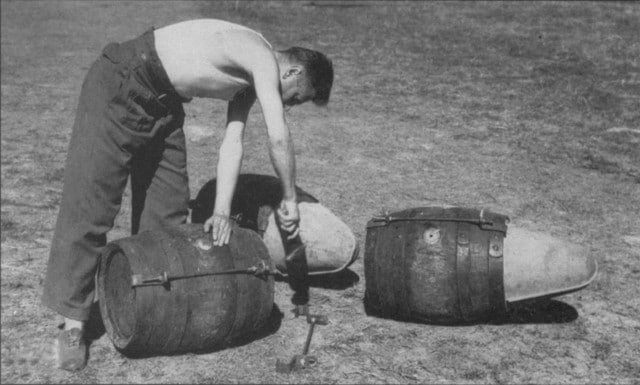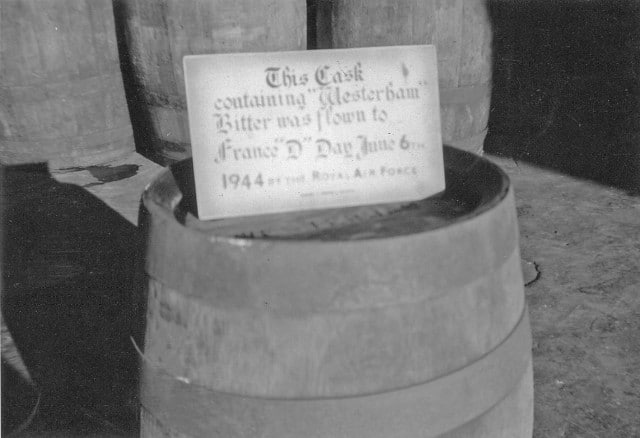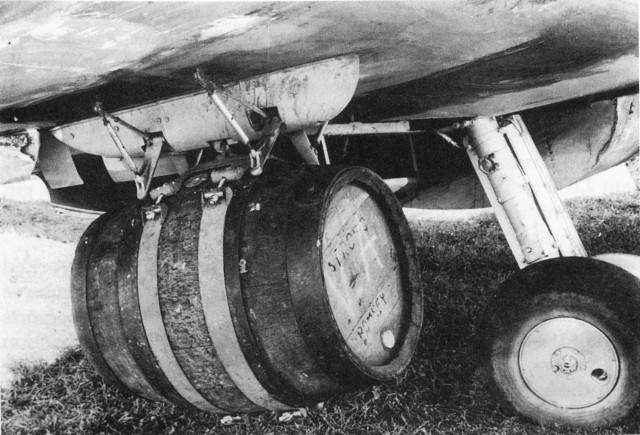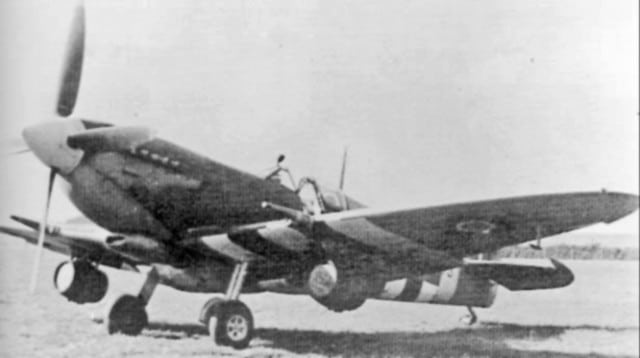You won’t believe this one weird trick they used to fly beer to the D-Day troops in Normandy
Today, I have a long and very interesting article for you which was originally published on the amazing Zythophile blog by Martyn Cornell. Martyn Cornell is an author, journalist and beer historian. Enjoy!
Normandy, 70 years ago, and one of the biggest concerns of the British troops who have made it over the channel, survived the landings and pushed out into the bocage against bitter German resistance is not the V1 flying bomb blitz threatening their families back home, nor the continued failure to capture the port of Cherbourg – but the lack of beer in the bridgehead. On 20 June 1944, two weeks after D-Day, Reuter’s special correspondent with the Allied Forces in France wrote to newspapers in the UK that all that was available in the newly liberated estaminets a few miles inland from the beaches was cider, “and it is pretty watery stuff. I saw a British private wistfully order a pint of mild and bitter: but the glass he sat down with contained the eternal cider.”
Tangmere, Sussex, July 1944: in front of a Spitfire IX of 332 (Norwegian) Squadron, a standard 45-gallon Typhoon/Hurricane ‘Torpedo’ jettison tank modified for use on the Spitfire (because of an expected shortage of 45-gallon shaped or slipper tanks) is filled with PA ale for flying over to Normandy while an RAF ‘erk’ writes a cheery message on the tank. The pilot sitting on the wing in this clearly posed government publicity picture is wearing a Norwegian Air Force cap-badge – something no one who has reprinted this picture seems ever to have pointed out. Is the man filling the tank a brewery worker? Surely. Is the beer from Henty and Constable’s brewery in nearby Chichester? It seems very likely …
Addendum: the pilot has now been identified as almost certainly being the Norwegian Spitfire ace Wing Commander Rolf Arne Berg, CO of No. 132 Norwegian Wing, who was killed a few months later, aged 27, in February 1945 while attacking a German airfield in the Netherlands.
It would not be until July 12 when “real British beer” finally officially reached the battling troops in Normandy, and even then the quantity was enough only for one pint per man. But long before then, enterprising pilots in the RAF – and the USAAF – had been engaged in shipping beer into Northern France privately, using what the troops called “flying pubs”.
Some of the first attempts to bring beer over the Channel after D-Day used the expendable drop tanks, or jettison tanks to give them their proper RAF designation, carried by aircraft such as the Spitfire and Typhoon and normally filled with fuel to give the fighters extra range. These seem to have been semi-official efforts: the Air Ministry actually distributed a photograph to newspapers showing a Spitfire of 332 (Norwegian) Squadron at Tangmere airfield in Sussex having its 45-gallon jettison tank being filled with beer from two wooden casks supplied by the Chichester brewer Henty & Constable, while the pilot relaxed on the wing. That pilot was almost certainly Wing Commander Rolf Arne Borg, commanding officer of No. 132 Norwegian wing, though the aircraft does not seem to be Berg’s, as his carried three rings in Norwegian red and blue on the spinner.
It was presumably 270 gallons of beer from Henty and Constable that was flown in drop tanks slung under three Spitfire Mk IXbs from Tangmere to an airfield at Bény-Sur-Mer in Normandy, some 110 miles south of England and three miles from the sea, on June 13 1944, D-Day plus seven: the first known landing of beer during the invasion. One of the pilots was Flight Lieutenant Lloyd Berryman of 412 Squadron, 126 Wing, Second Tactical Air Force, Royal Canadian Air Force. The airstrip at Bény-Sur-Mer would not, in fact, be finished officially for another two days when Berryman’s boss, Wing Commander Keith Hudson, singled him out at a briefing at the wing’s Tangmere base to deliver a “sizeable” beer consignment to the airstrip, known as B4.
Berryman recalled:
“The instructions went something like this, ‘Get a couple other pilots and arrange with the officers’ mess to steam out the jet [jettison] tanks and load them up with beer. When we get over the beachhead drop out of formation and land on the strip. We’re told the Nazis are fouling the drinking water, so it will be appreciated. There’s no trouble finding the strip, the battleship Rodney is firing salvoes on Caen and it’s immediately below. We’ll be flying over at 13,000 [feet] so the beer will be cold enough when you arrive.’
“I remember getting Murray Haver from Hamilton and a third pilot (whose name escapes me) to carry out the caper. In reflection it now seems like an appropriate Air Force gesture for which the erks (infantrymen) would be most appreciative. By the time I got down to 5,000 the welcoming from the Rodney was hardly inviting but sure enough there was the strip. Wheels down and in we go, three Spits with 90-gallon jet tanks fully loaded with cool beer.
“As I rolled to the end of the mesh runway it was hard to figure … there was absolutely no one in sight. What do we do now, I wondered, we can’t just sit here and wait for someone to show up. What’s with the communications? Finally I saw someone peering out at us from behind a tree and I waved frantically to get him out to the aircraft. Sure enough out bounds this army type and he climbs onto the wing with the welcome: ‘What the hell are you doing here?’ Whereupon he got a short, but nevertheless terse, version of the story.
“‘Look,’ he said, ‘can you see that church steeple at the far end of the strip? Well it’s loaded with German snipers and we’ve been all day trying to clear them out so you better drop your tanks and bugger off before it’s too late.’ In moments we were out of there, but such was the welcoming for the first Spitfire at our B4 airstrip in Normandy.”
Later, in the 1950s back in in Canada, by chance Berryman actually met the man who climbed onto his wing and told him to bugger off.
Four days after Berryman’s landing, on 17 June 1944, and 11 days after the invasion started, a Spitfire of 416 Squadron, Royal Canadian Air Force flew over from England to the newly built airfield at Bazenville, just three miles from Gold Beach, with a drop tank full of beer slung below its fuselage. The tank had been scoured out first with steam but “tough luck; it still tasted of petrol,” according to Dan Noonan, a Flight Commander with 416 Squadron.
The heftier Hawker Typhoon could carry even more beer. Pilots of the RAF’s 123 Wing, flying rocket-firing Typhoons and based from 19 July 1944 at Martragny, a few miles east of Bayeux, would run a “shufti-kite” across to Shoreham, 110 miles away, where a local brewery would fill two 90-gallon jettison tanks attached below each of the Typhoon’s wings with beer. Then the pilot would hurry back across the Channel and the RAF personnel at Martragny would drink it, quickly. There was one problem with transporting beer in jettison tanks: according to 123 Wing’s commanding officer, the New Zealand-born RAF ace Group Captain Desmond Scott, on the trip over to Normandy the beer “took on rather a metallic taste, but the wing made short work of it.”
However, the journey over the channel, at 15,000 feet or so, cooled the beer down nicely for when it reached those on the ground: indeed, according to newspaper reports, not only did Spitfires supply beer shortly after D-Day in jettison tanks made from vulcanised paper fibre, but P-47 Thunderbolt fighters, presumably flown by the USAAF, had carried iced custard, or ice-cream, in their drop-tanks to troops on the Normandy beachheads: “They flew at 15,000 feet and delivered their cargo iced in perfect condition.” (This is not as unlikely as it seems: the US army had mobile ice-cream making machines for the troops in the Second World War, and so did many US Navy ships.)
The Typhoons’ exploits were reported in Time Magazine on July 2 1944 under the headline “Flying Pubs”:
A great thirst attacked British troops rushing emergency landing strips to completion in the dust of Normandy. Thinking of luckier comrades guzzling in country estaminets and town bistros, the runway builders began to grouse. They wanted beer. They got it. Rocket-firing Typhoons, before going on to shoot up Nazis, landed on the runways with auxiliary fuel tanks full of beer. Swarms of the thirsty gathered round with enamel mugs. The first tank-fulls tasted bad because of the tank linings; this flavor was overcome by chemical means and later loads were delicious. Just like the corner pub at home.
Unfortunately, United States Army Air Forces P-47 Thunderbolts did for 123 Wing’s beer runs: the Typhoon was easily mistaken by inexperienced American pilots for the German Focke-Wulf Fw 190 fighter, and according to Group Captain Scott, “our aerial brewer’s dray was attacked by American Thunderbolts twice in one day, and was forced to jettison its beer tanks into the Channel … beer cost us money, and these two encounters proved expensive.” The Wing’s draught beer flights came to a sudden halt, and Scott had to arrange for an old twin-engined Anson to fly in cases of Guinness: “The troops mixed it with champagne to produce black velvet. It was hardly a cockney’s drink, but they appeared to like it,” he wrote.
It may have been 123 Wing’s experience that was covered in a publication called The Airman’s Almanac in 1945:
A possible peacetime use for the auxiliary fuel tanks attached to the underside of fighter planes in World War II to increase their range was demonstrated in the Normandy invasion of 1944. British ground crews, rushing emergency landing strips to completion in the dust and heat of the French province, complained of thirst. Their complaint being heard, rocket-firing Typhoons coming over from England on their way to German targets landed on the newly built strips with their military fuel tanks full of beer. The first tankfuls tasted awful because of the tank linings. Before the second ‘beer trip’ the tanks were treated chemically and the air-hauled brew was reported extremely palatable.
Ironically, Thunderbolt pilots learnt what the Typhoons had been doing, and copied it themselves. Lieutenant William R Dunn of the 513th Fighter Squadron, USAAF, the first American air ace of the Second World War, was a P-47 Thunderbolt pilot in Normandy.
He recorded:
During our brief stay at A6 airfield, we learned another trick of the trade from our neighbouring RAF allies, a Typhoon squadron based near Caen. Periodically they’d send a kite with a clean belly tank back to England, where the tank was filled with beer. A flight back to France at an altitude of about 15,000 feet and the beer arrived nice and cold. We soon followed their lead, with our 150-gallon belly tanks. Those British types sure know how to take all the comforts of home to war with them.
The other method used was to attach casks to the bomb racks. Pilots with the RAF’s No 131 (Polish) wing, flying Spitfire Mk IXs, (probably 302 Squadron or 308 Squadron, both fighter-bomber units) claimed to have invented the idea of the “beer bomb”, using casks that had home-made nose-cones fitted to make them more streamlined, which were fitted to the Spitfire’s bomb racks.
On 3 August 1944 131 Wing moved from England to the airfield at Plumentot, near Caen, and “beer bombing” began:
Even more popular was the ‘beer-bomb’, invented and first used by No. 131 Fighter Wing when still stationed in England. The bomb has nothing atomic about it, so the details can now be divulged. The invention is, in fact, simplicity itself: it entailed a barrel of beer, a bomb-carrying aircraft, and a willing pilot (the three were available in increasing order of magnitude). The procedure, freely disclosed for the benefit of thirsty humanity, was for the aircraft to be carefully ‘bombed up’ with a barrel of beer, flown off with every precaution to Plumentot in Normandy and landed with equal care. Never were bombs more warmly welcomed. Not least because of the dust.
Pictures exist of the “beer bombs” being put together: presumably at Ford airfield in West Sussex, where 302 and 308 squadrons were based just before they were moved to Plumentot, in which case, again, the beer may well have come from Henty and Constable, eight or so miles away at Chichester.
Above and below, ‘beer bombs’, wooden firkins being fitted with streamlined ‘nose cones’ for transporting in bomb racks underneath Spitfires by members of 131 Fighter Wing, probably in August 1944, possibly at Ford airfield in West Sussex. Pictures taken from Polish Wings 15 by Wojtek Matusiak, pub Stratus, 2012, p216, and © Stratus
One Kentish brewery that apparently supplied beer for transport across by fighter plane was Bushell Watkins & Smith of the Black Eagle brewery in Westerham.
According to Westerham villager Edward “Ted” Turner:
I worked at a garage called Brittain’s Engineering in Peckham in London making Bailey bridges for sending to France for the invasion … We were also making ‘jettison’ auxiliary fuel tanks for fighter planes to carry extra fuel to enable them to fly further into Europe and still get back home. Once refuelling facilities were established over there, the Westerham brewery used to fill those auxiliary non-returnable petrol tanks with Westerham ales for our troops in Europe. Black Eagle lorries delivered it in barrels to Biggin Hill [four miles from Westerham] where the auxiliary dual-purpose tanks were filled with Bitter on one side and Mild on the other. We made them of 16 gauge metal with baffles for safe landing, the RAF’s version of the brewer’s dray.
There is also a photograph of a cask at the Black Eagle brewery with a sign on it declaring: ‘This Cask containing “Westerham” Bitter was flown to France “D” day, June 6th 1944, by the Royal Air Force’. Unfortunately there are problems with the Westerham claims. The three fighter squadrons that had been using the airfield departed in late April 1944 for Tangmere, where they would be closer to the Normandy beaches. In any case, Biggin Hill was abandoned by the RAF soon after the Normandy landings. On June 13 1944, V1 “doodlebug” flying bomb attacks on London began, and Biggin Hill – right in the V1s’ flightpath – was deemed too dangerous to continue to be used by aircraft, with Balloon Command taking the airfield over as part of the line of barrage balloons put up against the doodlebugs. Flying operations did not begin again at Biggin Hill until September 1944, and fighter aircraft do not seem to have returned until the October. However, one of the squadrons that had been based at Biggin Hill until April 1944 was 412 Squadron, which had made that first “drop-tank beer delivery” to Normandy from Tangmere on June 13. It is possible that the beer in the tanks might have come from the Westerham brewery, 50 miles away, which the pilots of 412 would have known very well.
The Westerham Brewery’s ‘D-Day cask’. But were there any flights from nearby Biggin Hill over France on D-Day? © Westerham Brewery
Certainly, pilots were happy to fly long distances to pick up beer. Thorsteinn “Tony” Jonsson, the only Icelander to join the RAF, was flying North American Aviation P-51 Mustang III fighter-bombers with 65 Squadron, based at Ford, when the D-Day invasion began. On June 27 his squadron moved to the temporary airfield at Martragny, designated B7, five miles from Bayeux and only some 2000 yards from the German lines.
However, Jonsson recorded:
Life in our camp was really quite pleasant and comfortable. Admittedly we missed the luxury of being able to pop into a pub at the end of a day’s work for a pint of beer, and to mix with the ladies that were usually to be found there to add spice to our existence. At the beginning of the invasion and for the next few weeks, beer was severely rationed in Normandy … But some bright lad in our Wing had an excellent brain-wave; why not bring beer over from England in the large auxiliary tanks that could be hung under the wings of our Mustangs? Each tank could hold 75 gallons – this would make an excellent addition to our meagre ration. Action was immediately taken.
Four tanks were sent to a factory for their insides to be coated with a substance to prevent the taste of metal, as is done with preserving cans, and taps were fitted. A contract was made with a brewery in London, and on an appointed day every week a Mustang flew with two empty ‘beer’ tanks to Croydon aerodrome and brought back two full ones; one containing mild and the other bitter. These tanks were placed on trestles in our mess-tent, which quickly became known as the best pub in Normandy. It did not take long for the word to spread to nearby military units that we had a good supply of beer, and our mess was frequently a very popular and crowded place in the evenings. The fact that nurses from a military hospital in the neighbourhood were regulars only helped to boost the attendance … It was not long before the beer trips were increased to two a week. Although most pilots likes to nip over to England whenever possible, to contact families and loved ones, the beer-run was not in demand. The reason was that a full beer tank could easily fall off if the landing was not perfectly smooth. The ‘beer kite’s’ arrival was watched by all available personnel, and woe to the poor pilot who was unlucky enough to bounce!
It was 150 miles from Martragny to Croydon (at the time the main airfield in London), making the “beer run” for 65 Squadron a 300-mile round trip. Croydon’s one brewery was Page & Overton, a subsidiary of Charrington’s brewery in Mile End, and it was presumably Page & Overton’s mild and bitter that flew back in the tanks of the Mustangs.
Confirmation that Henty and Constable supplied much of the beer to arrived in Normandy after D-Day comes from Jeffrey Quill, chief test pilot at Vickers, the parent company of Supermarine, maker of the Spitfire.
Quill recalled:
After D-Day in 1944, there was a problem about getting beer over to the Normandy airfields. Henty and Constable (the Sussex brewers) were happy to make the stuff available at the 83 Group Support Unit at Ford, near Littlehampton. For some inexplicable reason, however, beer had a low priority rating on the available freight aircraft. So we adapted Spitfire bomb racks so that an 18-gallon barrel could be carried under each wing of the Spitfires which were being ferried across from Ford to Normandy on a daily basis.
We were, in fact, a little concerned about the strength situation of the barrels, and on application to Henty and Constables for basic stressing data we were astonished to find that the eventuality of being flown on the bomb racks of a Spitfire was a case which had not been taken into consideration in the design of the barrels. However, flight tests proved them to be up to the job. This installation, incidentally, was known as Mod XXX Depth charge.
A Spitfire IX fitted with the ‘Mod XXX Depth Charge’, modified bomb racks that could carry a cask of beer under each wing. Contrary to frequent claims, this is almost certainly a Vickers Armstrong publicity photo, and NOT Wing Commander Johnnie Johnson’s own aircraft
According to one source with a slightly different spin on the story, the job of designing fittings that would secure the kilderkins to the Spitfire’s bomb racks was done at High Post airfield, Salisbury, one of the final assembly centres for Spitfire manufacture, “more or less as a joke”. The plan to put beer in long-range tanks was abandoned “when it was found later that the practice contaminated fuel, so Strong’s, the Romsey brewers, supplied complete barrels of Triple ‘X’. This modification was given a fictitious number to conceal the operation from more official or officious eyes.”
There was already a link between Strong’s and Spitfires: after the Luftwaffe bombed Vickers-Supermarine’s headquarters in 1940, the company’s design and administration offices were transferred to Hursley Park, Winchester, a magnificent mansion requisitioned after the death that same year of its owner, Sir George Cooper, chairman of Strong’s. That Strong’s certainly was involved in the supply of casks to be carried on Spitfire bomb racks is confirmed by the existence of a photograph of just such a cask slung under a Spitfire wing, clearly branded “STRONG ROMSEY”.
A close-up of the “Mod XXX Depth charge” on the ground, showing clearly that the casks were supplied, at least occasionally, by Strong’s brewery in Romsey, Hampshire
The hint that Quill gave about the “flying drays” being replacement Spitfires ferried across to squadrons on the Normandy front line from England is given extra support by a newspaper story from the middle of August 1944:
With beer in their bomb racks, replacement Typhoons from England are sure of a specially boisterous welcome from the thirsty troops in Normandy. For the beer shortage is just as acute over there as it is in England. So at least one Typhoon squadron has solved its problem by importing its own beer.
Whenever a replacement aircraft flies to Normandy the pilot takes a quantity of beer, carrying it in nine-gallon barrels with special streamlined nose fittings slung in the bomb racks. This system has been found to be much better than the original method of taking the beer in petrol tanks, which gave the beer a nasty flavour.
In the event of the pilot running into trouble, the barrels are jettisoned as if they were bombs. Then another kind of trouble awaits him at the end of his journey.
Wing Commander Johnnie Johnson had landed with his 127 Wing, two squadrons of Canadians, at a newly built airfield at St Croix-sur-Mer, designated B3, and just over a mile and a half from the landing beaches, on D-Day plus 3. After several days of tinned “compo” rations, Johnson sent a note to his favourite Sussex landlord, Arthur King at the Unicorn in Chichester, asking for help. Every day a twin-engine Anson flew into St Croix from Tangmere with mail, newspapers and spare parts, and King arranged for items such as tomatoes, fresh lobsters, newly baked bread and “a reasonable supply of stout” to be carried across in the Anson with the mail.
When news of the arrangement leaked into the newspapers, King was visited by someone from Customs and Excise, who warned him that if he carried on, he would need an export licence.
However, Johnson recorded in his memoirs,
Since its introduction to the Service in 1939, the versatile Spitfire had participated in many diverse roles … Now it fulfilled yet another role, perhaps not so vital as some of the tasks it had undertaken in the past, but to us of supreme importance. Back in England some ingenious mind had modified the bomb racks slung under each wing so that a small barrel of beer could be carried instead of a 500-pound bomb. Daily, this modern version of the brewers’ dray flew across the Channel and alighted at St Croix. The beer suffered no ill effects from its unorthodox journey and was more than welcome in our mess.
Johnson’s memoir of the war, Wing Leader carried a photograph of a Spitfire IX in D-Day black-and-white stripes, carrying a kilderkin of beer slung from each bomb rack, and captioned “Our version of the brewer’s dray”. This seems to have given rise to the myth that the picture is of Johnson’s own Spitfire. But the photograph in the book is credited to Vickers Armstrong, and is almost certainly one of the aircraft manufacturer’s publicity shots, and nothing to do with Johnson.
A Spitfire IX bearing D-Day invasion stripes, and carrying beer casks beneath its wings, on the ground. It is probably significant that in none of the shots of beer-carrying aircraft can the identifying letters be seen: these were almost certainly all publicity shots
Eventually, organised supplies of beer for the troops supplanted the “flying drays”. In November 1944 the government actually ruled that supplies of beer for troops overseas should equal five per cent of total national production, meaning all stronger “export” beers, all naturally conditioned beers with a life of six weeks or more and all beers that could be pasteurised had to be put in the hands of the forces’ catering service, the Naafi. At the same time, breweries in liberated areas of France were being put to use.
By then it was the turn of the Home Front to be short of beer, however. Brewers blamed a shortage of labour, saying the women workers who had replaced men called up for the forces had themselves been evacuated with their children as the V1 and V2 threat increased. The Nottingham Evening Post reported that in some pubs there had been outbreaks of “panic drinking”, customers “gulping their beer and shouting for an encore lest their neighbours at the bar got more than they did.” At the same time, in “certain districts” only mild ale was available, because bitter, which kept better, was earmarked for the troops. Many pubs were only open for an hour and a half at lunchtimes and two hours in the evening because they had no beer to sell: and there was little relief even for those harvesting the grain that would be used to make the new season’s beers. In August 1944 it was announced that “In some parts of Lincolnshire the beer famine has become so acute that many inns have announced that they will not be able to continue the age-old custom of supplying harvest beer this season. Cups of tea will be provided instead.”
Martyn Cornell is a beer historian, a seven-times winner at the British Guild of Beer Writers awards, and author of Amber Gold and Black, the history of Britain’s many home grown beer styles, from porter to bitter to barley wine, which is available from Amazon. He has a new book out in July 2015, Strange Tales of Ale, which includes the story of the Great London Beer Flood of 1815, why British aristocrats drank 21-year-old beer and the true history of the ploughman’s lunch, among other stories, which is available for pre-ordering here: http://tiny.cc/g80gxx.

